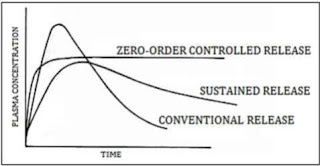SALICYLATES - Aspirin (prototype)
SALICYLATES
Aspirin (prototype)
Aspirin is acetylsalicylic acid. It is rapidly converted in the body to salicylic acid which is responsible for most of the actions. Other actions are the result of acetylation of certain macromolecules including COX. It is one of the oldest analgesic-antiinflammatory drugs and is still frequently used.
PHARMACOKINETICS
Aspirin is
absorbed from the stomach and small intestines. Its poor water solubility is
the limiting factor in absorption: microfining the drug-particles and inclusion
of an alkali (solubility is more at higher pH) enhances absorption. However,
higher pH also favours ionization, thus decreasing the diffusible form.
Aspirin is rapidly
deacetylated in the gut wall, liver, plasma and other tissues to release salicylic
acid which is the major circulating and active form. It is ~80% bound to plasma
proteins and has a volume of distribution ~0.17 L/kg. Entry into brain is slow,
but aspirin freely crosses placenta. Both aspirin and salicylic acid are
conjugated in liver with glycine to form salicyluric acid (major pathway). They
are also conjugated with glucuronic acid. Few other minor metabolites are also
produced. The metabolites are excreted by glomerular filtration and tubular
secretion. Normally, only 1/10th is excreted as free salicylic acid, but this
can be increased by alkalinization.
The plasma
t½ of aspirin as such is 15–20 min, but taken together with that of released
salicylic acid, it is 3–5 hours. However, metabolic processes get saturated
over the therapeutic range; t½ of antiinflammatory doses may be 8–12 hours while that during poisoning may be
as high as 30 hours. Thus, elimination is dose dependent.
ADVERSE EFFECTS
(a) Side effects that occur at analgesic dose
(0.3–1.5 g/day) are nausea, vomiting, epigastric distress, increased occult
blood loss in stools. The most important adverse effect of aspirin is gastric
mucosal damage and peptic ulceration.
(b) Hypersensitivity and idiosyncrasy Though infrequent,
these can be serious. Reactions include rashes, fixed drug eruption, urticaria,
rhinorrhoea, angioedema, asthma and anaphylactoid reaction. Profuse gastric
bleeding occurs in rare instances.
(c) Antiinflammatory doses (3–5 g/day) produce the syndrome called
salicylism—dizzi-ness, tinnitus, vertigo, reversible impairment of hearing and
vision, excitement and mental con-fusion, hyperventilation and electrolyte
imbalance. The dose has to be titrated to one which is just below that
producing these symptoms; tinnitus is a good guide.
Aspirin
therapy in children with rheumatoid arthritis has been found to raise serum
transami-nases, indicating liver damage. Most cases are asymptomatic but it is
potentially dangerous. An association has been noted between salicylate
therapy and
‘Reye’s syndrome’, a rare form of hepatic encephalopathy seen in children
having viral (varicella, influenza) infection.
In adults
also, long-term therapy with high dose aspirin can cause insidious onset
hepatic injury. Salt and water retention occurs in a dose related manner.
(d) Acute salicylate
poisoning It is more
common in children. Fatal dose in adults is estimated to be 15–30 g, but is
considerably lower in chil-dren. Serious toxicity is seen at serum salicylate
levels > 50 mg/dl.
Manifestations
are:
Vomiting,
dehydration, electrolyte imbalance, acidotic breathing, hyper/hypoglycaemia,
petechial haemorrhages, restlessness, delirium, hallucinations, hyperpyrexia,
convulsions, coma and death due to respiratory failure + cardiovascular
collapse.
Treatment is symptomatic and supportive. Most
important is external cooling and i.v. fluid with Na+, K+, HCO3¯ and glucose:
according to need determined by repeated monitoring. Gastric lavage to remove unabsorbed
drug; alkaline diuresis or haemodialysis to remove absorbed drug is indicated
in severe cases. Blood transfusion and vit K should be given if bleeding
occurs.
Precautions and
contraindications
• Aspirin is
contraindicated in patients who are sensitive to it and in peptic ulcer,
bleeding tendencies, in children suffering from chicken pox or influenza. Due
to risk of Reye’s syndrome pediatric formulations of aspirin are prohibited in
India and the UK.
• Cautious
use in chronic liver disease: cases of hepatic necrosis have been reported.
• It should
be avoided in diabetics, in those with low cardiac reserve or frank CHF and in
juvenile rheumatoid arthritis.
• Aspirin
should be stopped 1 week before elective surgery.
• Given
chronically during pregnancy it may be responsible for low birth weight babies.
Delayed or prolonged labour, greater postpartum blood loss and premature
closure of ductus arteriosus are possible if aspirin is taken at or near term.
• It should
be avoided by breastfeeding mothers.
• Avoid high
doses in G-6PD deficient individuals—haemolysis can occur.




Comments
Post a Comment
Thanks